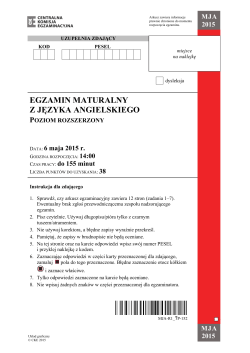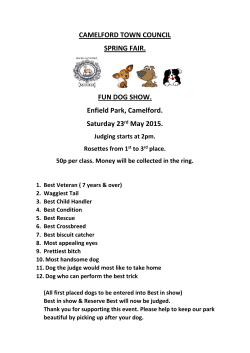
poziom rozszerzony
Arkusz zawiera informacje prawnie chronione do momentu rozpoczęcia egzaminu. MJA 2015 UZUPEŁNIA ZDAJĄCY KOD PESEL miejsce na naklejkę dysleksja EGZAMIN MATURALNY Z JĘZYKA ANGIELSKIEGO POZIOM ROZSZERZONY DATA: 6 maja 2015 r. GODZINA ROZPOCZĘCIA: 14:00 CZAS PRACY: 150 minut LICZBA PUNKTÓW DO UZYSKANIA: 50 Instrukcja dla zdającego 1. Sprawdź, czy arkusz egzaminacyjny zawiera 14 stron (zadania 1–10). Ewentualny brak zgłoś przewodniczącemu zespołu nadzorującego egzamin. 2. Teksty do zadań od 1. do 3. zostaną odtworzone z płyty CD. 3. Pisz czytelnie. Używaj długopisu/pióra tylko z czarnym tuszem/atramentem. 4. Nie używaj korektora, a błędne zapisy wyraźnie przekreśl. 5. Pamiętaj, że zapisy w brudnopisie nie będą oceniane. 6. Na tej stronie oraz na karcie odpowiedzi wpisz swój numer PESEL i przyklej naklejkę z kodem. 7. Zaznaczając odpowiedzi w części karty przeznaczonej dla zdającego, zamaluj pola do tego przeznaczone. Błędne zaznaczenie otocz kółkiem i zaznacz właściwe. 8. Tylko odpowiedzi zaznaczone na karcie będą oceniane. 9. Nie wpisuj żadnych znaków w części przeznaczonej dla egzaminatora. MJA-R1_1P-152 Układ graficzny © CKE 2015 MJA 2015 Zadanie 1. (0–3) Usłyszysz dwukrotnie trzy teksty. Z podanych odpowiedzi wybierz właściwą, zgodną z treścią nagrania. Zakreśl literę A, B albo C. Tekst 1. 1.1. When talking to a friend, the woman A. criticises people who do not follow the dress code at work. B. expresses her opinion on the dress code at her workplace. C. supports new dress code regulations at her office. Tekst 2. 1.2. What is the speaker doing? A. presenting a panel of judges B. hosting a competition on TV C. introducing the guests of a programme Tekst 3. 1.3. Which of the following is stated in the text as an opinion, not a fact? A. In medieval times football matches were played to solve conflicts. B. Football matches nowadays unify fans rather than provoke fights. C. The media are to blame for the negative image of football fans. Zadanie 2. (0–4) Usłyszysz dwukrotnie cztery wypowiedzi na temat schronisk dla zwierząt. Do każdej wypowiedzi (2.1.–2.4.) dopasuj odpowiadające jej zdanie (A–E). Wpisz rozwiązania do tabeli. Uwaga: jedno zdanie zostało podane dodatkowo i nie pasuje do żadnej wypowiedzi. This speaker mentions A. ideas for entertaining animals living in a shelter. B. an amount of money already donated to finance an animal shelter. C. animals placed in a shelter temporarily. D. legislation which will soon be introduced. E. the need to change current legislation concerning cruelty to animals. 2.1. 2.2. 2.3. Strona 2 z 14 2.4. MJA-1R Zadanie 3. (0–5) Usłyszysz dwukrotnie wywiad z profesorem Thomasem Jacksonem na temat lądowania na Księżycu. Z podanych odpowiedzi wybierz właściwą, zgodną z treścią nagrania. Zakreśl literę A, B, C albo D. 3.1. The spacesuits which the astronauts wore A. were equipped with tubes filled with air. B. helped to control the astronauts’ body temperature. C. carried away excess water to the cooling system. D. had a sophisticated texture absorbing space radiation. 3.2. John Young’s shadow in the photograph does not appear natural because A. this picture is in fact fake. B. the sunlight fell from the right side. C. he was in mid-air when the photo was taken. D. he lost his balance when saluting the American flag. 3.3. According to Professor Jackson, the Moon rock samples brought back by Apollo A. are older than any rocks of Earth origin. B. resemble rocks produced artificially. C. come from a different source than meteorites. D. have the same features as some Earth rocks. 3.4. The Soviets gave up the idea of landing on the Moon because A. they felt discouraged by the difficulties faced by the Americans. B. the cost of the mission would have been higher than they had expected. C. they focused too much on the preliminary stage of the project. D. the mission ceased to be a challenge for them after the American success. 3.5. In the interview, Professor Jackson A. questions the need for space exploration. B. explains why people come up with hoax theories. C. criticises NASA for abandoning the space race to the Moon. D. dismisses doubts concerning the US landing on the Moon. PRZENIEŚ ROZWIĄZANIA ZADAŃ OD 1. DO 3. NA KARTĘ ODPOWIEDZI! MJA-1R Strona 3 z 14 Zadanie 4. (0–4) Przeczytaj tekst, który został podzielony na trzy części (A–C) oraz pytania go dotyczące (4.1.–4.4.). Do każdego pytania dopasuj właściwą część tekstu. Wpisz rozwiązania do tabeli. Uwaga: jedna część tekstu pasuje do dwóch pytań. In which paragraph does the author mention 4.1. the inconveniences which cinema-goers have to put up with? 4.2. typical distractions which might occur when we watch a movie on a plane? 4.3. an opportunity to judge fellow passengers’ choice of films? 4.4. taking pleasure in something she usually avoids? WHY I LOVE WATCHING MOVIES ON PLANES by Catherine Shoard A. Thirty thousand feet up, you are both God and ant. You survey the world beneath you as attentive staff serve refreshments and snacks. And yet you have no control over your own fate. You can’t exit and you can’t turn back. You are a hostage, at the mercy of others. Shocking as it may seem, this is what makes me love long flights, and especially watching movies on them. You have just a few options so you watch whatever is on, guilt-free. That’s how I have seen most romantic comedies in my life. I generally consider them a waste of time and at home I do all I can not to watch them, but in the air they become a true source of enjoyment. B. The regulations or personal tastes of the programme planners who work for airlines are a mystery to me. The choice often seems quite random. Just looking through the lists of what Air Canada considers avant-garde, contemporary or a new release is an entertainment in itself. But surely there are some guidelines, probably something like: if a film can’t cope with being viewed on a tiny screen, interrupted with beeps, meals, safety announcements and sudden drops in altitude, it has no place on a plane. C. There are some advantages, though. The movie goes straight from your individual screen into your brain, unfiltered by environmental factors. There are no strangers obstructing the view of the screen to those in the stalls behind, a partner commenting on the scene or kids munching popcorn. And while it’s rude to stare at what the commuter sitting next to you on the tube is watching or reading, on a plane you just can’t avoid it. Pop to the bathroom and as you return, you have no choice but to evaluate the personal taste of other travellers, whether you like it or not. adapted from www.theguardian.com PRZENIEŚ ROZWIĄZANIA NA KARTĘ ODPOWIEDZI! Strona 4 z 14 MJA-1R Zadanie 5. (0–4) Przeczytaj tekst, z którego usunięto cztery fragmenty. Wpisz w luki 5.1.–5.4. litery, którymi oznaczono brakujące fragmenty (A–E), tak aby otrzymać logiczny i spójny tekst. Uwaga: jeden fragment został podany dodatkowo i nie pasuje do żadnej luki. THE MAPS OF THE FUTURE The modern map is no longer a printed publication we struggle with on a mountain peak, but digital, data-rich and dynamic. Thanks to satellite navigation, GPS-enabled smartphones, social networking and 3D visualisation technology, maps are becoming almost unlimited in their functionality and capable of incorporating real-time updates. 5.1. _____ For instance, tourists will be able to plan their trips by using their phones to project a 3D map onto a wall. Then they’ll be able to manipulate it remotely with their fingers, adding layers of information such as landmarks, restaurants, recommendations from friends, as well as transport links and times. As digital maps can now be linked to an almost infinite number of data sets, they’re also going to become more personalised. Cyclists or surfers, for example, will be able to add whatever information they find relevant. And soon we may not only be visualising maps. 5.2. _____ This kind of function in a map would also be an obvious advantage for people whose sight is impaired. Not only does geo-location help us know where we are and what there is of interest around us, it can also show us where everyone else is, and what they think is useful and interesting. 5.3. _____ Consequently, we receive real-time alerts from fellow drivers, and hopefully enjoy a less frustrating journey. In my area, over 1,500 motorists drove 105,000 miles and posted and shared 528 road alerts in the last week alone. Of course, a system based on collecting data from users’ posts works better when more people take part, so if the number is smaller, it might not always be 100% reliable. 5.4. _____ National emergency services spring to mind first when one thinks of the users of the more precise, dynamically-updated maps which are currently available. While new interaction technologies are making maps richer, there is still one underlying theme uniting all maps throughout history – location. We’ll always need to know where we are. adapted from www.bbc.co.uk A. Thus, maps are becoming social. Many navigation applications for mobile phones are incorporating live updates from their community of users to give commuters tips on how to avoid traffic jams. B. And in the years to come the way we interact with maps will undergo even more transformations. C. It’s said that about one billion hours of travel time and 3.5 billion litres of fuel are saved globally due to improved navigation. D. Nevertheless, there is no doubt that such services can improve the accuracy of maps to the benefit of all. E. They may be talking to us, too. Words are sometimes better than pictures, particularly if you don’t want to keep stopping to look at your smartphone. PRZENIEŚ ROZWIĄZANIA NA KARTĘ ODPOWIEDZI! MJA-1R Strona 5 z 14 Zadanie 6. (0–5) Przeczytaj dwa teksty na temat pracy. Z podanych odpowiedzi wybierz właściwą, zgodną z treścią tekstu. Zakreśl literę A, B, C albo D. Tekst 1. A CHANCE When I finally decided to give up busking, I felt a mixture of emotions. Part of me was angry, however, another part of me began to see I had an opportunity to put the past behind me. I knew I couldn’t carry on singing on street corners all my life. I had to move on. That was all very well in theory, of course. But no one was going to give me a job. It wasn’t because I was stupid, I knew that. Thanks to the IT work I’d done when I was a teenager back in Australia, I was fairly knowledgeable when it came to computers. But I didn’t have any relevant experience in the UK to rely on and if a prospective employer asked me where I’d spent the past ten years, I wouldn’t be able to say I’d been working for Google or Microsoft. So I had to forget that. There wasn’t even any point in my applying to do a training course in computing because they wouldn’t accept me. I had been homeless for years and didn’t even have an O level to my name. I realised that there was only one option – selling the Big Issue1. I didn’t have the luxury of waiting for something else to turn up. So the next day I set off for Covent Garden. I had to find Sam, the area’s Big Issue coordinator. Selling the Big Issue is not easy. People often come up to you and say “get a job”. They think that the sellers are given the magazines for free but it’s not the case. The philosophy of the Big Issue is “you have to have money to make money”. You get a small number of free magazines only on the first day. Once you’ve sold them, you purchase further copies for £1.25 and sell them for £2.50, thereby making a £1.25 income per copy. You need to plan carefully how many magazines you buy every day because if you make no money, you can’t afford copies to sell the next day. I had tried it once, yet, for me it hadn’t worked out. I gave it up after a few months but I could still remember some of the grim, monotonous days I’d spent trying to tempt Londoners to part with their cash in return for a magazine. But I’d been invisible. They would turn their backs on me or do all they could to avoid me. That’s why I’d turned to busking, at least then I had my music to attract people’s attention. I wouldn’t have considered going back to selling the Big Issue if it hadn’t been for my cat, Bob. He had transformed my fortunes on the street incredibly. If I could do as well selling the Big Issue as I’d done busking with Bob, then my life would take a turn for the better. adapted from A Street Cat Named Bob by James Bowen 1 Big Issue – a magazine published on behalf of and sold by homeless people. Strona 6 z 14 MJA-1R 6.1. In the second paragraph, the narrator explains why A. he had no previous experience in computing. B. his skills were irrelevant in Australia. C. an IT job was not an option for him in the UK. D. Google and Microsoft turned down his job application. 6.2. People who sell the Big Issue in the street A. have to be able to manage their finances. B. collect money for the charity of their choice. C. get a few free copies of the magazine every day. D. are paid a fixed salary regardless of the number of copies sold. 6.3. When the narrator recalls his first experience of selling the Big Issue, he mentions A. the tricks he used to attract the attention of potential buyers. B. the joyful moments with his cat accompanying him at work. C. the severe depression he luckily managed to overcome. D. the behaviour of people passing him by in the street. MJA-1R Strona 7 z 14 Tekst 2. WALKING DOGS FOR A LIVING Gazing out on a sunny summer day from behind the office desks, there are few people who have never thought of being a river guide or a rancher. For many dog lovers, those outdoorsy dreams concern dog walking. It’s a common misconception that dog walking is undemanding. No doubt this illusion stems from the humble beginnings of the profession. Once upon the 1960s, people simply paid the kid down the street a dollar to take Fido out for them. As we’ve packed ourselves into tighter urban spaces with growing crime rates and heavier traffic, the risks involved in a kid walking Fido no longer allow for that solution. But pet owners have even less time and available space to walk Fido, who still needs regular, vigorous exercise beyond what he can get in our small backyards. That’s why professional dog walking was born. And a professional is what it takes to safely navigate six to eight unruly dogs through heavily used natural spaces. Unaware of the hardships, many walkers start out with the experience of walking their own pets. Soon they realize the job involves more than it’s commonly believed. It starts with having the appropriate licences. It’s about interacting skillfully with other trail users and knowing what to do if a fight breaks out. Bad weather brings its own set of trials such as cleaning up soaked and muddy pets. That, however, is not all there is to dog walking. Most of all, it is a business like any other and as such it involves paperwork, customer service, accounting, and an endless list of rules and regulations most of us are not aware of. Still, a lot of dog walkers think they have the best job in the world. One former lawyer once told me, “My worst day on the trail is better than the best day in my old job.” adapted from www.dogtec.org 6.4. One of the reasons why professional dog walking started was that A. there appeared more vigorous breeds of dogs which needed more exercise. B. dog owners could afford to pay more for having their pets walked. C. city dwellers moved to houses without backyards. D. walking dogs was no longer safe for kids. 6.5. In the third paragraph, the author A. ridicules people who give up professional careers for dog walking. B. makes the reader aware of the challenges dog walkers have to face. C. expresses his doubts whether teenagers should engage in dog walking. D. explains why new rules regulating the dog walking profession are necessary. PRZENIEŚ ROZWIĄZANIA NA KARTĘ ODPOWIEDZI! Strona 8 z 14 MJA-1R Zadanie 7. (0–4) Przeczytaj tekst. Z podanych odpowiedzi wybierz właściwą, tak aby otrzymać logiczny i gramatycznie poprawny tekst. Zakreśl literę A, B, C albo D. SUPER BOWL COMMERCIALS Television advertisements are typically skipped, but when it 7.1. _____ to Super Bowl commercials, that’s not the case. The vast majority of Super Bowl spectators are Americans, and they eagerly await breaks in the big game to see which commercials impress them the most. In the days to follow, national surveys will judge which advertisement carried the best viewer response. Over the past decades ads 7.2. _____ an increasingly significant aspect of the event. Sometimes they are discussed even more than the game 7.3. _____. Which commercials cost the most to make? Which ones were surprisingly cheap? These are the two most frequently asked questions. 7.4. _____ the answers, one of the most popular commercials was a Doritos tortilla chips advert which cost only about $500 to make. Altogether, around 60 commercials were broadcast throughout the game, with prices up to $4 million for 30-second slots. adapted from www.people.howstuffworks.com 7.1. 7.2. A. B. C. D. adds goes passes comes 7.3. A. B. C. D. have become had become are to become will have become A. B. C. D. If only The more Due to As for 7.4. A. B. C. D. by oneself aside itself for its sake PRZENIEŚ ROZWIĄZANIA NA KARTĘ ODPOWIEDZI! MJA-1R Strona 9 z 14 Zadanie 8. (0–4) Przeczytaj tekst. Uzupełnij każdą lukę (8.1.–8.4.) jednym wyrazem, tak aby powstał spójny i logiczny tekst. Wymagana jest pełna poprawność gramatyczna i ortograficzna wpisywanych wyrazów. THE NEWSPAPER OF TOMORROW Should we think of the newspaper as an everlasting institution? It might seem that the newspaper was born many generations ago and, 8.1. _______________ very recently, had no competition. Of course this is not true. In the 1920s, it was the invention of the radio 8.2. _______________ was supposed to kill the newspaper. Then it was TV news and the Internet. The newspaper has evolved and adapted. One of the examples of such changes is the disappearance of the evening edition newspaper due to TV news. Visions of what newspapers might 8.3. _______________ like in the future varied throughout the 20th century. In the 21st century they’ve taken the form of a multimedia product that lives on your tablet. One thing is certain – newspapers will continue to evolve for many decades 8.4. _______________ come, becoming more and more technologically advanced. adapted from www.blogs.smithsonianmag.com Zadanie 9. (0–4) Uzupełnij zdania 9.1.–9.4., wykorzystując podane w nawiasach wyrazy w odpowiedniej formie. Nie należy zmieniać kolejności podanych wyrazów, trzeba natomiast – jeżeli jest to konieczne – dodać inne wyrazy, tak aby otrzymać logiczne i gramatycznie poprawne zdania. Wymagana jest pełna poprawność ortograficzna wpisywanych fragmentów. Uwaga: w każdą lukę możesz wpisać maksymalnie pięć wyrazów, wliczając w to wyrazy już podane. 9.1. When I was a lecturer at university, I (use / speak / public) ________________________ ________________________________________________ at least three times a week, but since I retired it has happened only occasionally. 9.2. I have to write down this limerick. I won’t manage (learn / it / heart) ________________ __________________________________________________________ in five minutes. 9.3. The manager’s sarcastic comments (prevent / I / express) _________________________ __________________________________________ my opinion at the last meeting. 9.4. If I knew how to ski, I (go / ski) _____________________________________________ with a group of friends last weekend. Strona 10 z 14 MJA-1R Zadanie 10. (0–13) Wypowiedz się na jeden z poniższych tematów. Wypowiedź powinna zawierać od 200 do 250 słów i spełniać wszystkie wymogi typowe dla formy wskazanej w poleceniu. Zaznacz temat, który wybrałeś(-aś), zakreślając jego numer. 1. Coraz częściej słyszymy o osobach, które decydują się wyruszyć samotnie na trudną wyprawę – opłynąć Ziemię, dotrzeć na biegun, zdobyć niedostępny szczyt itp. Napisz rozprawkę, w której przedstawisz wady i zalety odbycia takiej wyprawy samotnie. 2. Jedna z gazet ogłosiła konkurs na pomysł kampanii zachęcającej do oszczędzania wody. Napisz list do redakcji. Opisz w nim sytuację, dzięki której uświadomiłeś(-aś) sobie wagę tego problemu, i przedstaw swoją propozycję takiej kampanii. CZYSTOPIS …...................……….................................................................................................................... ....................................................................................................................................................... ....................................................................................................................................................... ....................................................................................................................................................... ....................................................................................................................................................... ....................................................................................................................................................... ....................................................................................................................................................... ....................................................................................................................................................... ....................................................................................................................................................... ....................................................................................................................................................... ....................................................................................................................................................... ....................................................................................................................................................... ....................................................................................................................................................... ....................................................................................................................................................... ....................................................................................................................................................... ....................................................................................................................................................... ....................................................................................................................................................... MJA-1R Strona 11 z 14 ....................................................................................................................................................... ....................................................................................................................................................... ....................................................................................................................................................... ....................................................................................................................................................... ....................................................................................................................................................... ....................................................................................................................................................... ....................................................................................................................................................... ....................................................................................................................................................... ....................................................................................................................................................... ....................................................................................................................................................... ....................................................................................................................................................... ....................................................................................................................................................... ....................................................................................................................................................... ....................................................................................................................................................... ....................................................................................................................................................... ....................................................................................................................................................... ....................................................................................................................................................... ....................................................................................................................................................... ....................................................................................................................................................... ....................................................................................................................................................... ....................................................................................................................................................... ....................................................................................................................................................... ....................................................................................................................................................... ....................................................................................................................................................... ....................................................................................................................................................... Strona 12 z 14 MJA-1R ....................................................................................................................................................... ....................................................................................................................................................... ....................................................................................................................................................... ....................................................................................................................................................... ....................................................................................................................................................... ....................................................................................................................................................... ....................................................................................................................................................... ....................................................................................................................................................... ....................................................................................................................................................... ....................................................................................................................................................... ....................................................................................................................................................... ....................................................................................................................................................... ....................................................................................................................................................... ....................................................................................................................................................... ....................................................................................................................................................... ....................................................................................................................................................... ....................................................................................................................................................... ....................................................................................................................................................... ....................................................................................................................................................... ....................................................................................................................................................... Zgodność z poleceniem Spójność i logika Zakres środków językowych Poprawność środków językowych 0-1-2-3-4-5 0-1-2 0-1-2-3 0-1-2-3 Elementy treści (0-1-2) 1 2 MJA-1R 3 4 Elementy formy (0-1) 5 1 2 3 4 Strona 13 z 14 RAZEM BRUDNOPIS (nie podlega ocenie) Strona 14 z 14 MJA-1R
© Copyright 2025










